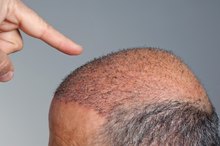What does fact checked mean?
At Healthfully, we strive to deliver objective content that is accurate and up-to-date. Our team periodically reviews articles in order to ensure content quality. The sources cited below consist of evidence from peer-reviewed journals, prominent medical organizations, academic associations, and government data.
The information contained on this site is for informational purposes only, and should not be used as a substitute for the advice of a professional health care provider. Please check with the appropriate physician regarding health questions and concerns. Although we strive to deliver accurate and up-to-date information, no guarantee to that effect is made.
How to Remove Facial Hair Growing Out of Moles
Moles are a result of an accumulation of melanin -- pigment -- on one area of the skin. The life cycle of a common mole lasts about 50 years, meaning your mole may eventually disappear if you wait long enough. Sometimes one or more hairs grow out of a mole; while not a sign of cancer, this can be a cosmetic annoyance. If the hair bothers you, you can remove it at home.
Inspect the mole visually before attempting hair removal to determine if it is likely to be cancerous. Most moles are harmless, notes the Cleveland Clinic, however, it is a good idea to inspect moles regularly for signs of cancer 2. Warning signs of potentially cancerous or pre-cancerous moles are: an irregular shaped mole --not round; a multi-colored mole; a mole that does not have definitive borders around the edges; and a mole that is larger in diameter than a pencil eraser. If any of these describes your mole, have it checked by a dermatologist as soon as possible to rule out cancer.
Why Do Moles Grow Black Hair?
Learn More
Pull the skin tight around the mole, using your fingers. The hair will remove with more ease from taut skin than it will from loose skin.
Pluck out the hair growing from the mole, using a pair of tweezers. Grasp the hair with the tweezers, as close to the root of the hair as possible, for the easiest removal. Squeeze the tweezers together tightly and pull away from the skin to remove the hair.
How to Tell if Hair is Growing Back
Learn More
Cut the hair off using a pair of nail clippers if you find the thought of pulling hair out of your mole painful. Place the nail clippers as close to the skin as possible and cut the hair, while being careful to avoid cutting the skin.
Visit a dermatologist to discuss permanent hair removal or mole removal, if you desire a permanent solution. Electrolysis is one effective method of permanent hair removal. If you want to undergo electrolysis, you will need to visit a dermatologist first to make sure the mole is not cancerous, as most electrologists will not work on moles without a dermatologist’s approval.
Tips
To reduce pain, apply a topical numbing gel to the mole before plucking the hair. Over-the-counter baby teething gels work well.
Warnings
Shaving, waxing and chemical depilatories tend to irritate moles. The irritation is harmless but can cause discomfort.
Related Articles
References
- American Academy of Dermatology: Moles: Signs and Symptoms
- Cleveland Clinic: Moles
- Bhatt M, Nabatian A, Kriegel D, Khorasani H. Does an increased number of moles correlate to a higher risk of melanoma?. Melanoma Manag. 2016;3(2):85-87. doi:10.2217/mmt-2016-0001
- Sardana K, Chakravarty P, Goel K. Optimal management of common acquired melanocytic nevi (moles): current perspectives. Clin Cosmet Investig Dermatol. 2014;7:89-103. doi:10.2147/CCID.S57782
- Fink E. [Health behavior from the gender perspective--The concept of "doing genders" and the perspective of intersectionality as an explanation]. Gesundheitswesen. 2015;77(11):880. doi:10.1055/s-2006-949120
- Wu S, Han J, Li WQ, Li T, Qureshi AA. Basal-cell carcinoma incidence and associated risk factors in U.S. women and men. Am J Epidemiol. 2013;178(6):890-7. doi:10.1093/aje/kwt073
- Barnhill, RL, and H Rabinovitz. “Benign Melanocytic Neoplasms.” Dermatology, 2nd Ed. Eds. Jean Bolognia, et. al. Mosby, 2008. 1723-6.
Writer Bio
Rose Kivi has been a writer for more than 10 years. She has a background in the nursing field, wildlife rehabilitation and habitat conservation. Kivi has authored educational textbooks, patient health care pamphlets, animal husbandry guides, outdoor survival manuals and was a contributing writer for two books in the Uncle John’s Bathroom Reader Series.








